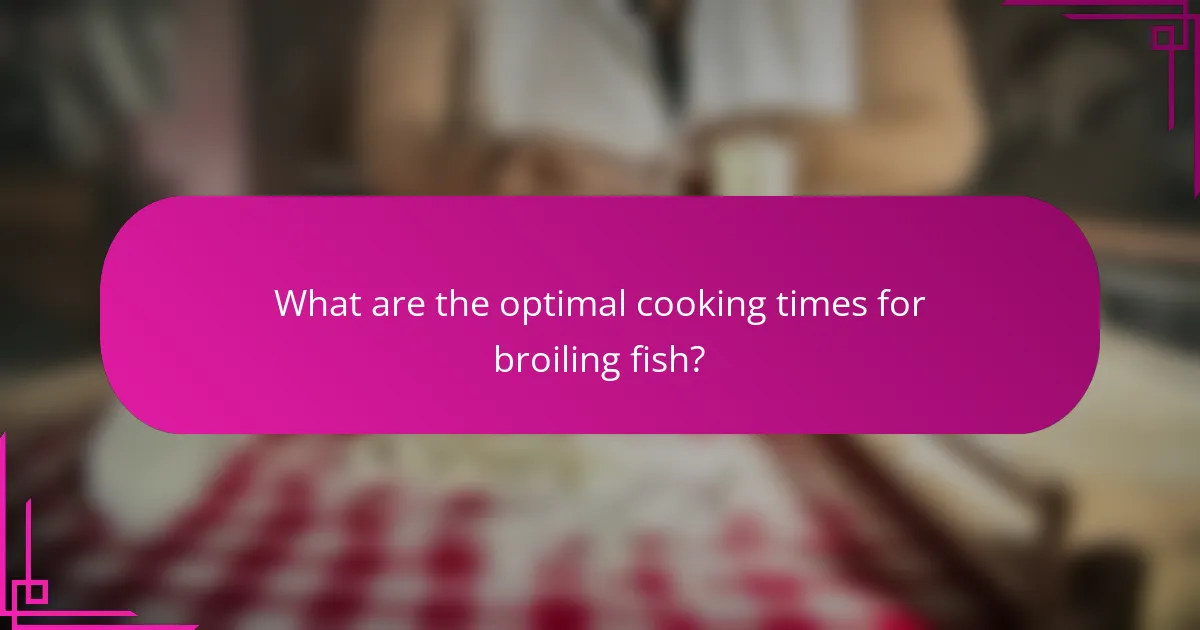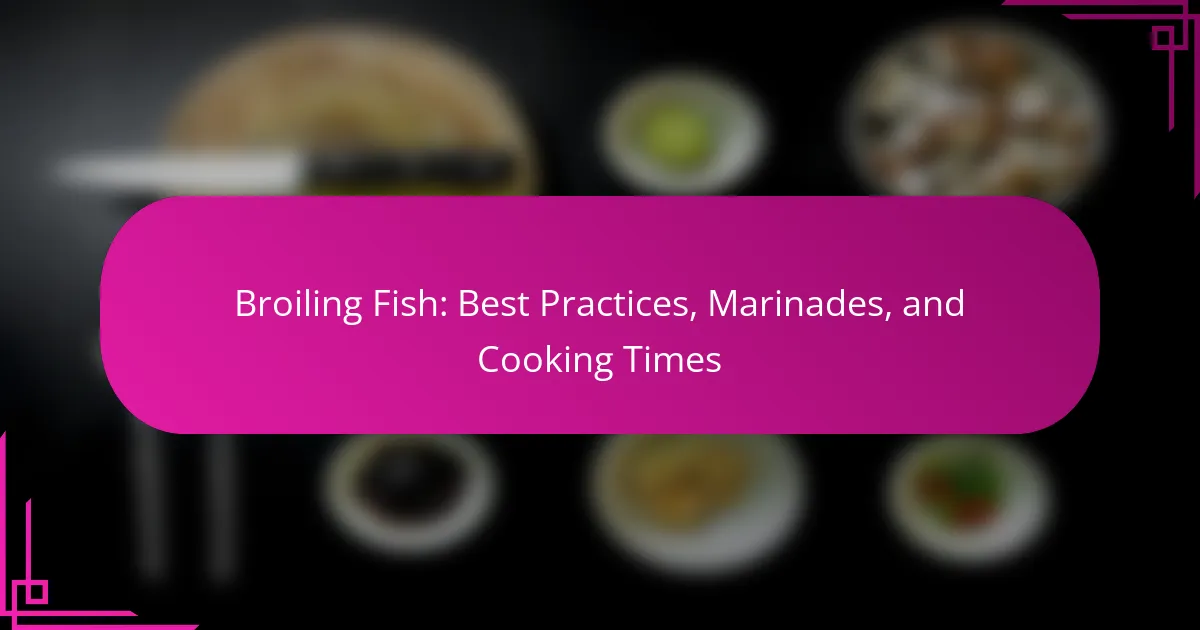Broiling fish is a cooking method that utilizes direct high heat, typically from an oven’s broiler setting, to quickly cook fish while creating a crispy exterior. This article outlines best practices for broiling fish, including proper pan preparation, seasoning techniques, and monitoring cooking times to ensure optimal doneness. It also discusses various marinades that enhance flavor, such as citrus-based, herb-infused, and soy sauce options. Additionally, the article provides guidelines for cooking times based on fish thickness, ensuring that the fish reaches a safe internal temperature of 145°F while retaining moisture and flavor.

What is Broiling Fish?
Broiling fish is a cooking method that involves exposing fish to direct high heat. This technique typically uses an oven’s broiler setting. The fish is placed on a broiler pan or baking sheet. The intense heat cooks the fish quickly, creating a crispy exterior. Broiling is an efficient way to prepare various types of fish. It preserves moisture while enhancing flavor. This method is often used for fillets and whole fish. Proper broiling requires careful monitoring to prevent overcooking.
How does the broiling process work for fish?
Broiling fish involves cooking it with high, direct heat from above. This method allows for quick cooking while achieving a browned, crispy exterior. The fish is typically placed on a broiler pan or baking sheet. The broiler’s heat source, often an electric or gas element, radiates intense heat. Fish cooks rapidly, usually within 5 to 10 minutes, depending on thickness. The internal temperature should reach 145°F for safe consumption. Broiling enhances the fish’s natural flavors and can be complemented with marinades or seasonings. This technique is efficient for a variety of fish types, including salmon, trout, and tilapia.
What are the key steps involved in broiling fish?
The key steps involved in broiling fish include preparing the fish, preheating the broiler, placing the fish on a broiling pan, seasoning it, broiling, and checking for doneness. First, clean and pat the fish dry. This ensures even cooking and better seasoning adherence. Next, preheat the broiler for about 5 to 10 minutes. This step is crucial for achieving a proper sear. Then, place the fish on a broiling pan, which allows fat to drain away during cooking. Season the fish with salt, pepper, and any desired herbs or marinades. Broil the fish for about 5 to 10 minutes per inch of thickness. Keep a close eye on the fish to prevent burning. Finally, check for doneness by ensuring the fish flakes easily with a fork. This indicates that it is fully cooked.
What equipment is necessary for broiling fish?
A broiler pan is necessary for broiling fish. This pan typically has a slotted top to allow fat to drip away. It also helps distribute heat evenly. An oven or broiler with a high temperature setting is essential. A fish spatula is useful for flipping the fish without breaking it. Aluminum foil can be used to line the pan for easier cleanup. An oven mitt is important to handle hot equipment safely. A meat thermometer ensures the fish reaches the correct internal temperature. These items collectively facilitate the broiling process effectively.
What are the advantages of broiling fish?
Broiling fish offers several advantages. It cooks fish quickly while retaining moisture. The high heat creates a caramelized crust, enhancing flavor. Broiling also reduces the need for added fats, making it a healthier cooking method. This technique preserves the nutrients in fish, such as omega-3 fatty acids. Additionally, broiling is convenient and requires minimal preparation. It allows for even cooking, ensuring that fish is tender and flaky. Overall, broiling is an efficient way to prepare delicious and nutritious fish dishes.
How does broiling enhance the flavor of fish?
Broiling enhances the flavor of fish by exposing it to high, direct heat. This cooking method caramelizes the fish’s natural sugars. It creates a crispy exterior while keeping the inside moist. The intense heat intensifies the fish’s natural flavors. Broiling also allows for the addition of marinades or seasonings that can infuse the fish. This technique is quick, usually taking only a few minutes. Fish cooked under a broiler can develop a rich, savory taste. Studies show that broiling can enhance flavor compounds in fish, making it more appealing.
What nutritional benefits does broiling fish provide?
Broiling fish offers several nutritional benefits. It preserves essential nutrients such as omega-3 fatty acids. Omega-3 fatty acids are known to support heart health and reduce inflammation. Broiling also minimizes the need for added fats or oils, keeping calorie counts lower. This cooking method retains high levels of protein, which is crucial for muscle repair and growth. Additionally, broiling helps maintain vitamins and minerals, including vitamin D and selenium. Research indicates that fish consumption is linked to improved cognitive function. Overall, broiling fish is a healthy cooking method that enhances its nutritional profile.

What are the best practices for broiling fish?
The best practices for broiling fish include using a clean broiler pan and preheating the broiler. Fish should be placed skin-side down on the pan. Season the fish with herbs, spices, or marinades for enhanced flavor. Maintain a distance of about 4 to 6 inches from the heat source. Broil fish for about 5 to 7 minutes per half-inch thickness. Check for doneness by ensuring the fish flakes easily with a fork. Use a meat thermometer to confirm an internal temperature of 145°F. Finally, let the fish rest briefly before serving for optimal texture.
How should fish be prepared before broiling?
Fish should be cleaned and filleted before broiling. Remove scales using a scaler or the back of a knife. Rinse the fish under cold water to eliminate any remaining debris. Pat the fish dry with paper towels to ensure even cooking. Season the fish with salt, pepper, and any desired herbs or marinades. Allow the fish to marinate for at least 15 to 30 minutes for enhanced flavor. Preheat the broiler to high heat before placing the fish on a broiler pan. This preparation ensures optimal taste and texture during broiling.
What types of fish are best suited for broiling?
Fish that are best suited for broiling include salmon, trout, mackerel, and swordfish. These fish have a firm texture that holds up well under high heat. Salmon is rich in omega-3 fatty acids, making it a healthy choice. Trout offers a delicate flavor that enhances with broiling. Mackerel is oily, which helps prevent drying out during cooking. Swordfish has a meaty texture that is ideal for broiling. All these fish can be seasoned or marinated to enhance their natural flavors. Broiling these types of fish results in a crispy exterior while keeping the inside moist and tender.
How can fish be seasoned effectively for broiling?
To season fish effectively for broiling, use a combination of salt, pepper, and herbs or spices. Salt enhances the natural flavor of the fish. Pepper adds a mild heat that complements the dish. Fresh herbs like parsley, dill, or thyme can provide aromatic notes. Spices such as paprika or garlic powder can contribute depth of flavor. Additionally, marinating the fish in a mixture of oil, lemon juice, and seasonings for 30 minutes can infuse it with taste. This technique is supported by culinary practices that emphasize seasoning as a crucial step in enhancing fish dishes.
What safety tips should be considered when broiling fish?
When broiling fish, ensure proper food safety practices are followed. Always thaw fish in the refrigerator, not at room temperature. Use a food thermometer to check that fish reaches an internal temperature of 145°F. Avoid cross-contamination by using separate utensils for raw and cooked fish. Keep the broiler clean to prevent smoke and flare-ups. Monitor cooking closely to prevent burning. Use a broiler pan to allow fat to drip away from the fish. Finally, let the fish rest for a few minutes before serving to allow juices to redistribute.
How can you prevent fish from sticking to the broiler?
To prevent fish from sticking to the broiler, use a non-stick spray or oil on the broiler rack. This creates a barrier between the fish and the metal surface. Additionally, preheating the broiler before placing the fish helps to sear the surface quickly. This searing action can reduce sticking. Choosing fish with a higher fat content, like salmon, also helps as the natural oils can minimize adhesion. Finally, using parchment paper or aluminum foil can provide an extra layer of protection against sticking.
What precautions should be taken to avoid overcooking?
To avoid overcooking fish, monitor cooking time closely. Fish typically cooks quickly, often within 10 to 15 minutes. Use a food thermometer to check the internal temperature. The safe cooking temperature for fish is 145°F (63°C). Preheat the broiler to ensure even cooking. Position the fish at least 4 to 6 inches from the heat source. Baste the fish with marinade to retain moisture. Check for doneness by flaking the fish with a fork; it should be opaque and separate easily. These precautions help maintain the fish’s texture and flavor.

What marinades work best for broiling fish?
Citrus-based marinades work best for broiling fish. These marinades often include ingredients like lemon, lime, or orange juice. The acidity helps to tenderize the fish. Additionally, they add bright flavors that enhance the taste. Herb-infused marinades, such as those with dill or parsley, also complement fish well. Soy sauce-based marinades provide a savory depth. They can include garlic and ginger for added complexity. Marinades should be applied for at least 30 minutes before cooking. This allows the flavors to penetrate the fish effectively.
What are the key ingredients in effective fish marinades?
Key ingredients in effective fish marinades include acid, oil, herbs, and spices. Acid, such as lemon juice or vinegar, helps to tenderize the fish. Oil, like olive oil, adds moisture and flavor. Fresh herbs, such as dill or parsley, enhance the overall taste. Spices, including garlic or pepper, provide additional depth. These components work together to create a balanced and flavorful marinade. Studies show that marinating fish can improve flavor and texture significantly.
How long should fish be marinated before broiling?
Fish should be marinated for 15 to 30 minutes before broiling. Marinating enhances flavor and can help tenderize the fish. A shorter marination time is suitable for delicate fish like tilapia or sole. Denser fish like salmon or swordfish can benefit from the full 30 minutes. Marinating for too long may lead to a mushy texture, especially with acidic marinades. This timeframe is widely recommended by culinary experts and cooking resources.
What are some popular marinade recipes for fish?
Popular marinade recipes for fish include lemon herb, soy ginger, and garlic butter. The lemon herb marinade combines fresh lemon juice, olive oil, garlic, and herbs like parsley or dill. This mixture enhances the fish’s natural flavors. The soy ginger marinade features soy sauce, fresh ginger, garlic, and honey. This blend adds a savory and slightly sweet taste. The garlic butter marinade consists of melted butter, minced garlic, and lemon juice. This rich sauce complements the fish’s texture and taste. Each marinade infuses the fish with distinct flavors, making them favorites among home cooks.
How do marinades affect the flavor and texture of broiled fish?
Marinades significantly enhance the flavor and texture of broiled fish. They infuse the fish with various flavors, such as herbs, spices, and acids. The acidic components in marinades, like citrus juice or vinegar, help to tenderize the fish. This process breaks down proteins, making the fish more succulent. Additionally, marinades can create a flavorful crust when broiled. The sugars in some marinades caramelize during cooking, adding depth to the flavor profile. Studies show that marinating fish for at least 30 minutes can improve taste and texture. Overall, marinades are essential for achieving a delicious and tender broiled fish dish.
What is the role of acidity in fish marinades?
Acidity in fish marinades serves to tenderize the fish and enhance flavor. Acidic ingredients such as lemon juice, vinegar, or yogurt break down proteins in the fish. This process makes the fish more succulent and flavorful. Additionally, acidity can help to neutralize fishy odors. The marination time impacts the degree of tenderness achieved. Generally, a short marination of 30 minutes to 2 hours is sufficient. Longer marination can lead to a mushy texture due to excessive protein breakdown. Therefore, the role of acidity is crucial for both flavor enhancement and textural improvement in fish marinades.
How can different marinades complement various types of fish?
Different marinades can enhance the flavor and texture of various types of fish. For instance, acidic marinades, like those containing citrus or vinegar, can tenderize fish and add brightness. Fat-based marinades, such as those with olive oil, can help retain moisture during cooking.
Herb-based marinades provide aromatic qualities that pair well with delicate fish like sole or flounder. Spicy marinades can add depth and complexity, suitable for robust fish like salmon or tuna. Sweet marinades, often with honey or brown sugar, can caramelize during cooking, creating a flavorful crust.
Research shows that marinating fish for at least 30 minutes can significantly improve its taste and texture. The right marinade can complement the natural flavors of the fish while also enhancing its overall culinary experience.

What are the optimal cooking times for broiling fish?
Optimal cooking times for broiling fish range from 5 to 10 minutes per inch of thickness. Fish fillets typically require about 6 to 8 minutes for every half-inch of thickness. Thicker cuts, such as salmon steaks, may need closer to 10 minutes. The fish should be cooked until it flakes easily with a fork. The internal temperature should reach 145°F for safe consumption. These guidelines ensure the fish is cooked properly while retaining moisture and flavor.
How do you determine the cooking time based on fish thickness?
To determine cooking time based on fish thickness, use a general rule of 10 minutes per inch of thickness. This applies to cooking fish at 400°F (204°C). For example, a fish fillet that is 1 inch thick should be cooked for about 10 minutes. If the fillet is 1.5 inches thick, increase the cooking time to 15 minutes. This method ensures even cooking throughout the fish. Additionally, thicker cuts may require checking for doneness with a thermometer. The internal temperature should reach 145°F (63°C) for safe consumption. Following these guidelines helps achieve perfectly cooked fish.
What are the general cooking time guidelines for different types of fish?
Cooking time guidelines for different types of fish vary based on thickness and type. Generally, fish should be cooked for about 10 minutes per inch of thickness. For example, salmon fillets typically require 10 to 15 minutes when broiled. White fish, such as cod or haddock, often cooks in 8 to 12 minutes. Shellfish like shrimp usually take around 5 to 7 minutes. Tuna steaks, being thicker, can take 8 to 10 minutes. These times ensure the fish is cooked through while remaining moist. Cooking times are crucial for food safety and optimal flavor.
How can you tell when broiled fish is perfectly cooked?
Broiled fish is perfectly cooked when it flakes easily with a fork and reaches an internal temperature of 145°F. The flesh should appear opaque and maintain a moist texture. Overcooked fish becomes dry and tough. A good indicator is the color change; it should transition from translucent to white. Additionally, the fish should have a slightly firm texture when pressed. These signs confirm that the fish is cooked through while retaining its natural flavors.
What are some common mistakes to avoid when broiling fish?
Common mistakes to avoid when broiling fish include not preheating the broiler. Preheating ensures even cooking and prevents sticking. Another mistake is using fish that is too thick. Thicker fish may not cook evenly, leading to a raw center. Additionally, neglecting to oil the fish or the broiler pan can result in sticking. It’s also important to avoid overcrowding the broiler. Overcrowding can trap steam and prevent proper browning. Not monitoring the cooking time is another common error. Fish cooks quickly under a broiler, so frequent checks are necessary. Lastly, skipping marination can lead to bland flavor. Marinating enhances taste and moisture, improving the overall dish.
How can improper cooking times affect the quality of broiled fish?
Improper cooking times can lead to poor quality in broiled fish. Overcooking fish results in a dry texture and loss of flavor. Fish should be cooked to an internal temperature of 145°F for optimal moisture retention. Undercooking can pose health risks due to potential pathogens. The ideal cooking time varies by fish type and thickness. For example, a one-inch thick fillet typically requires about 8-10 minutes of broiling. Inaccurate timing can also affect the fish’s visual appeal, resulting in an unappetizing appearance. Proper timing ensures a flaky texture and preserves essential nutrients.
What should you do if the fish is overcooked or undercooked?
If the fish is overcooked, consider using it in a different dish. Shredding it for fish tacos or mixing it into a salad can add moisture. If the fish is undercooked, return it to the heat source. Ensure it reaches a minimum internal temperature of 145°F for safety. Checking with a food thermometer confirms proper cooking. Adjust cooking time based on thickness and type of fish. These methods help salvage the dish effectively.
What are some practical tips for successful broiling of fish?
To successfully broil fish, preheat the broiler for even cooking. Position the oven rack about 4-6 inches from the heat source. Use a broiler-safe pan to prevent sticking. Lightly oil the fish to enhance flavor and prevent it from drying out. Season the fish with salt, pepper, and herbs for added taste. Broil the fish for about 5-10 minutes, depending on thickness. Fish should be opaque and flake easily with a fork when done. Monitor closely to avoid overcooking, as fish can dry out quickly.
Broiling fish is a cooking method that utilizes direct high heat to quickly prepare various types of fish, resulting in a crispy exterior while preserving moisture and flavor. The article covers essential techniques for broiling fish, including preparation steps, necessary equipment, and best practices for achieving optimal results. It also explores effective marinades that enhance taste and texture, along with guidelines for cooking times based on fish thickness. Additionally, the article highlights common mistakes to avoid and provides practical tips for successful broiling, ensuring a delicious and nutritious fish dish.
